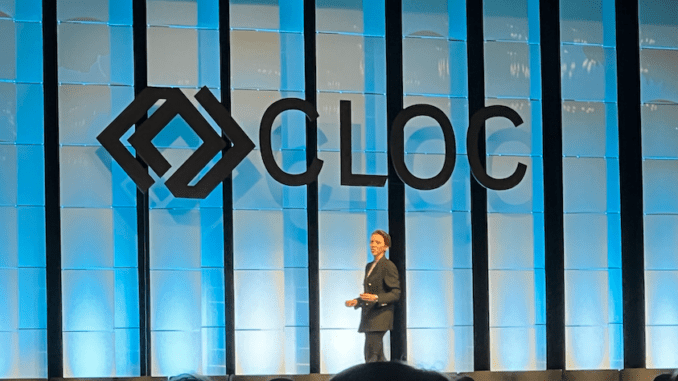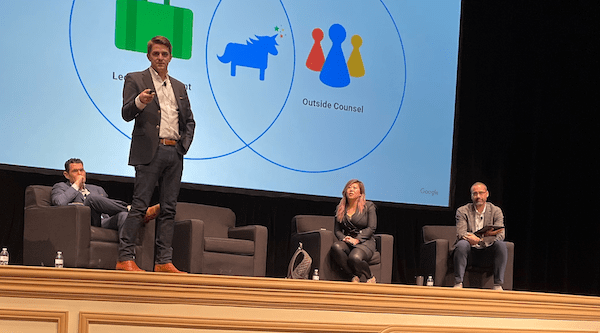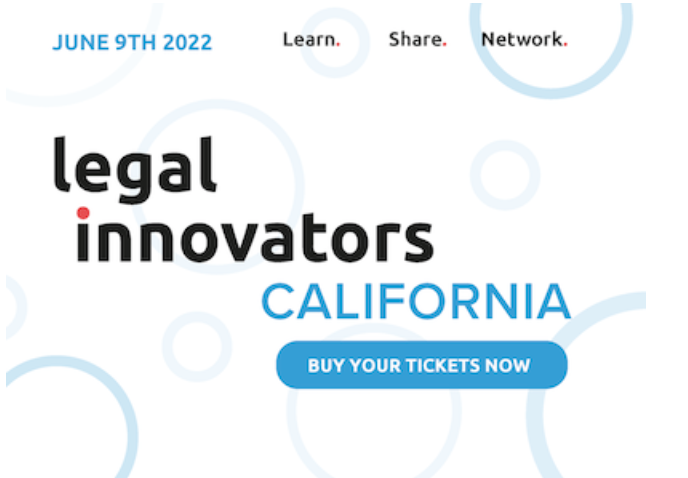
By Casey Flaherty, Chief Strategy Officer, LexFusion.
The CLOC Global Institute began with a story to a full house.
Jenn McCarron (pictured above) was spellbinding on the CGI stage as she took the audience through her personal journey, from the dive bars she played as a touring musician, to a temp job as an office manager that turned into the first of several legal operations roles (her initial title ‘paralegal/contracts compliance manager/legal assistant/technology officer’ gave the crowd the giggles), culminating in Jenn’s appearance before us as Director of Legal Operations & Technology at Netflix and a CLOC Executive Board Member.
Jenn is an expert storyteller. My friend Justin Hectus of KPLabs put it best in response to a text I sent him expressing praise for Jenn, with whom he works closely. Justin quoted the song Killer Queen and described Jenn appropriately as ‘dynamite with a laser beam’.
Jenn was an impossible act to top, but the perfect act to complement. CLOC Executive Board President, and Head of Legal Operations at Intel, Mike Haven, contextualized Jenn’s journey in the broader story that is the growth of legal operations as a profession and the resulting ascent of CLOC (see Dispatch #1). Mike told the story of a moment and a movement in a way that brought the room together, and laid the foundation for what came next.
Unfortunately, I simply cannot do what followed justice. ‘You just had to be there,’ is the worst journalism imaginable. But this is simply not my story to tell.
CGI brought in Robert Fogarty of Dear World [ a personal storytelling company ] to lead us in a collective exercise. To ground the exercise, Frances Pomposo, Senior Director Legal Operations & Chief of Staff to General Counsel at Workday, shared her own story – having nothing to do with legal operations. Frances’s story was deeply personal, riveting, vulnerable, powerful…..and a thousand other adjectives that are entirely inadequate, as well as unhelpful to the readers of this piece.
In the packed ballroom, however, Frances had a profound impact. She imbued the resulting storytelling exercise with an uncommon sense of meaning. Indeed, I already knew my exercise partner, Tracey Nobis. Yet, I learned more about her from the three-minute story she told me than I had over many hours of conversation over the course of many years. This is saying something, since one of our more recent conversations inspired me to write a blog post (Maybe, Don’t Be MacGyver) and inspired Tracey to explore her career options, which eventually resulted in her taking her new role as Manager of Legal Operations at James Hardie.
I will remember Jenn’s, Frances’s, and Tracey’s stories forever. Stories are superior for memory formation. Stories provide structure. Stories activate emotions. Stories meet our need for coherence, binding facts and ideas in a digestible way. Stories, in short, are how we make sense of the world.
Stories were also the theme of the day. The powerful opening session was bookended by a final session on value storytelling from Jae Um (Six Parsecs), Jason Barnwell (Microsoft), Aaron Boersma (Google), and me (LexFusion).

Every great story begins with a well-defined audience and that is where Aaron started our exploration of value storytelling. He spoke about being a good audience.
As the Legal Operations, Strategic Pricing & Analysis Lead at Google, Aaron is in the top 0.01% of the population on the receiving end of law firm pitches, especially rate-increase requests. Aaron considers it his job, and those of his in-house colleagues, to help firms craft their narratives.
While it is incumbent on law firms to frame their value proposition in terms of business outcomes, it is incumbent on in-house teams to provide firms the requisite organizational context in which those outcomes will be situated.
In particular, Aaron emphasized that firms need to articulate what they do, where they help, how they are different, and why their ask is fair (which is not the same as cheap). Reciprocally, clients should avoid arbitrary negotiations (negotiating for negotiation’s sake), listen proactively, and interpret meaning in good faith – including constructive feedback to assist the firm in future interactions.
I picked up the baton from Aaron and asked our audience to imagine a law firm whose core value proposition was merely being cheaper than the alternatives. I then explained that, in essence, this is how many law departments present themselves to their internal stakeholders.
If you read Dispatch #1 or my series on value storytelling, you are already familiar with my messaging: savings is not a sustainable strategy.
Savings-centric narratives work – until they don’t – because they reinforce the attractive fiction that corporations can, and should, spend less on legal. When this framing inevitably conflicts with reality, law departments find themselves in a bind. They are no longer able to make good on their perpetual ‘savings’ commitments. Worse, they have made the hard job of competing for finite corporate resources materially harder by painting themselves into a narrative corner. I concluded that the growth in complexity in the environment in which businesses operate made it imperative for law departments to change the narrative.
Jason Barnwell has done just that at Microsoft, where he is General Manager for Digital Transformation of Corporate, External, and Legal Affairs. Jason founded a transformation team premised on the central role of stories: ‘We believe our transformation will be built on great stories that help our people find their place in our future.’ (See here for the origin story of Jason’s role, as well as here and here for Jason’s recent contributions to Artificial Lawyer).
Among his many insights, Jason shared an experiment his team is running to transform a three-day turnaround time for specific BAU legal work into a three-minute turnaround time. Jason highlighted how this is a story that goes beyond savings (‘we saved lawyer time’) and, rather, speaks to true business value (‘we are enabling the business to move faster’). Materially enhanced speed due to substantially reduced friction is a story the business understands in its own terms.
Jason’s approach centers on the business stakeholders – i.e., the true audience. And making our audience, not ourselves, the hero of our stories was at the center of Jae Um’s masterful close. Jae explained the cold logic to a room filled with would-be change agents that ‘we are in the feelings business’ and recognizing this requires us to interrogate the stories we tell ourselves.
While resistance to change in others may evoke many feelings in us, it is a critical error to turn these feelings into a tragic tale where our stakeholders are our enemy and the conflict between us gives our story its propulsive force. Rather, they are the star, and we are their ally in trying to slay whatever dragon threatens us both. In short, we’re in this together – which was the narrative thread throughout all of the stories told on the first day of CGI.
—
Many thanks to Casey for this third dispatch from the CLOC CGI event in Las Vegas, written for Artificial Lawyer.
—
About the Author:

Casey Flaherty is the Chief Strategy Officer of LexFusion, which helps clients to engage with a collaborative circle of curated legal innovation companies. Previously he has been: Director of Legal Project Management at Baker McKenzie, Corporate Counsel at Kia Motors America, and an Associate at Holland & Knight. (N.B. Main pic credit also to Casey.)
—
Conference Promotion: Legal Innovators California – June 9 – San Francisco.

Legal Innovators California – June 9, San Francisco – All-Day, In-Person Legal Innovation Conference.
If you found the themes discussed here of interest then come along to Legal Innovators California conference on June 9, in San Francisco, where we will be exploring a range of subjects, from legal ops to legal tech and much more, with many great speakers from across the industry.
Ticket information can be found here.
